Q1 2024 Wrap Up
Published by Callum McLaughlin 14 / 04 / 24
Q1 2024 has given plenty for us to look back on, including the launch of Balancing Reserve, flattening of wholesale power prices, an increase in Balancing Mechanism activity though the Open Balancing Platform, and two record highs in the Capacity Market.
Frequency Services
In January and February, revenue in DCMR markets remained consistent with the last two months of 2023, when clearing prices reduced as a result of the introduction of the Enduring Auction Capability (EAC) by ESO on the 3rd of November.
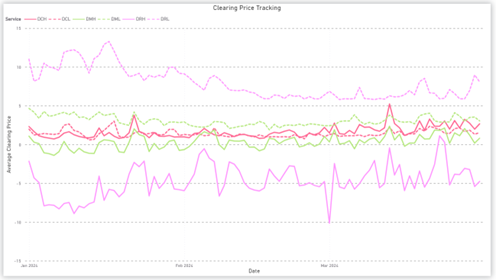
DC prices bucked that trend in March, with average DCL prices increasing 29% and average DCH prices increasing 66% from February. This can be explained, at least partially, by the introduction of Balancing Reserve (BR) on 12th March (more detail on this below), as, since BR launched, volumes tendered into DC services per EFA reduced by 6%, suggesting that prices are still very sensitive to the volumes available. Wind generation has also been changeable in March, which has also influenced the prices in these services.
Balancing Reserve
The new Balancing Reserve (BR) service was launched by National Grid on 12th March, with Flexitricity among the first 10 companies to enter the auction. This is a day-ahead auction, which is designed to secure capacity that ESO can then dispatch via the Balancing Mechanism (BM). In Positive Balancing Reserve (PBR), which is capacity for Offers, ESO has consistently procured an average of 400MW per settlement period. Negative Balancing Reserve (NBR), capacity for Bids, has been much more variable, with ESO procuring volumes averaging 78MW per settlement period, but ranging between 0MW and 400MW.
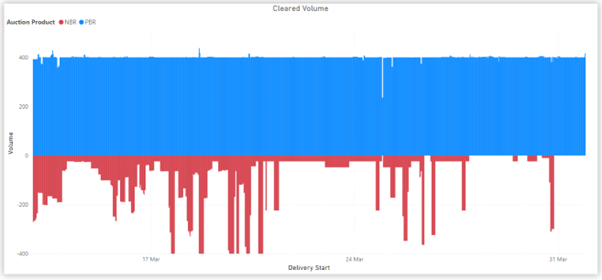
The first couple of days of the service saw some big price variations in PBR, seeing highs of £29.21/MW/h, but this has since settled with much lower spreads in the prices and an average clearing price of £3.80/MW/h. NBR has not seen similar spikes in prices, with a highest clearing price of £1.60/MW/h and an average of £0.60/MW/h.
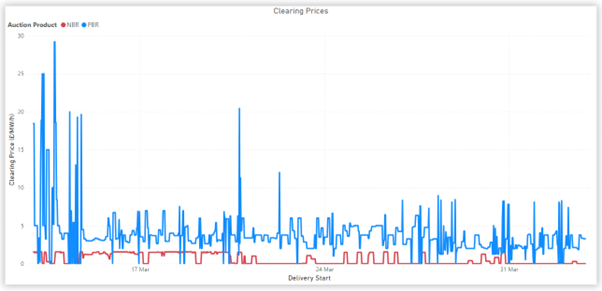
Balancing Reserve is still a very new market which we’ll watch with interest over the next few months.
Wholesale Market
In the wholesale market, Weighted Average Prices (WAP) for power across all markets have dropped around 20% in Q1 vs Q4 2023, to £64.40/MWh (down from £81.38/MWh). There has also been a lack of scarcity pricing and less volatility, leading to lower spreads which have averaged around £45/MWh vs spreads of £90/MWh in Q4 2023.
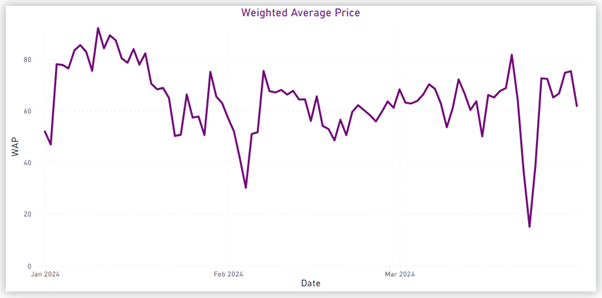
In part, the trends seen in wholesale markets in Q1 can be explained by lower gas and carbon prices, with EU storage levels high for this time of year and low domestic demand, caused by high temperatures for the time of year, contributing to this. With prices for these two commodities falling, coupled with an increase in wind generation, this means the cost of generation is much lower leading to the lower, more stable power prices we’ve seen this quarter.
Balancing Mechanism (BM)
The Open Balancing Platform (OBP) was relaunched National Grid ESO’s control room for Battery Energy Storage System (BESS) assets on 10th January, after initially launching on 12th December and being withdrawn after only a couple of service due to some technical issues. The aim of OBP is to improve the dispatch of assets in the BM, making it more efficient for the ESO to procure the volumes it needs to balance the system. The number of individual Bid Offer Acceptances (BOA) instructions for BESS assets has increased by 400% in Q1 compared to the last quarter of 2023, with the MWh volume dispatched increasing 157%.
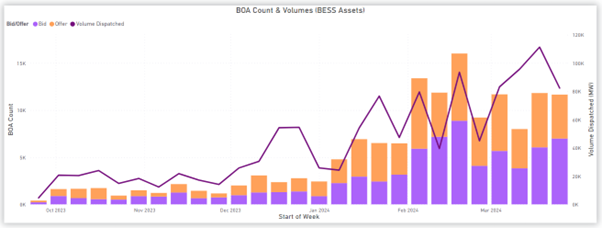
The ESO also introduced the “30-minute rule” for BESS assets in the BM during March. This change, from the “15-minute rule” previously in place, means that the Maximum Export Limit (MEL) and Maximum Import Limit (MIL) submitted to ESO by operators must reflect the maximum power that can be delivered for 30 instead of 15 minutes. This change was implemented by the ESO and providers over a two-week transition period, which ran from 11th March to 25th March. We have seen average BOA durations for BESS assets increase throughout March, however that increase is to levels that we’d already seen at the beginning of Q1 so it’s too early to tell what the longer-term impact of this change will be.
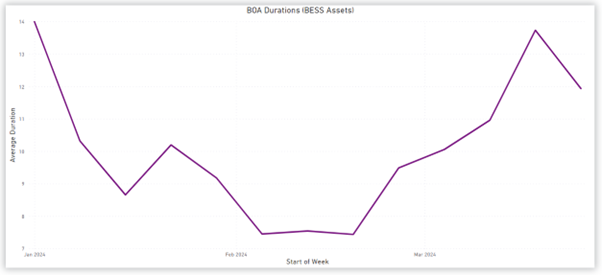
Capacity Market
February brought the annual Capacity Market auctions, each with slightly different interesting points. The T-1 auction procured the highest volume of capacity ever in a year ahead “top up” auction, and the T-4 auction cleared at its highest price ever.
We have full reviews of each auction:
Get in touch today
Book a call with one of our energy market specialists to find out if you can participate and how much your site could earn.
0131 221 8100